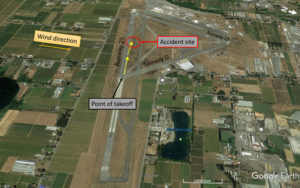March 28, 2019
TSB Cites Crosswind in Dragon Rapide Crash
admincopa
In a Transportation Safety Board Investigation Report issued on March 28, investigators cited a strong crosswind as a possible factor that led to the crash of a vintage de Havilland DH-89A Dragon Rapide shortly after takeoff during the Abbotsford International Airshow at British Columbia’s Abbotsford airport (CYXX) last July.
ATC ground controllers had advised the Dragon pilot that winds were 180° at 11 knots, gusting to 18. Runway 19 was available, but aircraft displays occupied 60 percent of the runway’s length. The pilot decided to use Runway 25 instead, commencing the takeoff roll from its intersection of Taxiway D. The crosswind component was calculated to be 18 knots at the moment of takeoff. The Dragon encountered gusting winds approximately 30 feet above the runway and lost airspeed, causing it to nose over and crash just beyond the edge of Runway 25. The pilot and one passenger were seriously injured, and two passengers sustained minor injuries.

The TSB investigators determined the pilot was properly licensed. They also noted that the Dragon is known to be underpowered and difficult to control in crosswinds. The investigators point out that since the Dragon has only a single pilot position (along the centreline of the cockpit), pilot training on the model is difficult.
The aircraft, operated by U.S.-based Historic Flight Foundation (HFF), was being used to provide rides for paying members of the public. However, the investigation revealed that the flight authority that the aircraft was operating under (an FAA-issued Special Airworthiness Certificate – Experimental) did not allow for the carrying of passengers in Canada. Transport Canada had issued a special authorization (Foreign Flight Authority) to the HFF to fly the Dragon into Canada, but this permit does not allow for the carriage of passengers for hire or reward.
The complete TSB Investigation Report can be found here.
